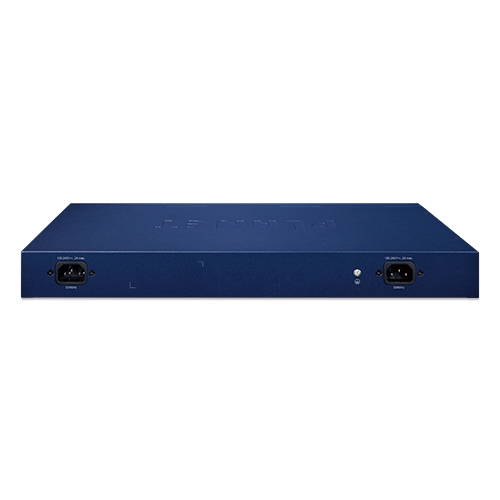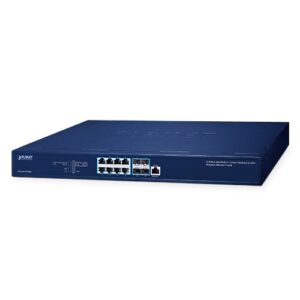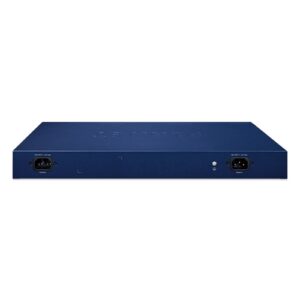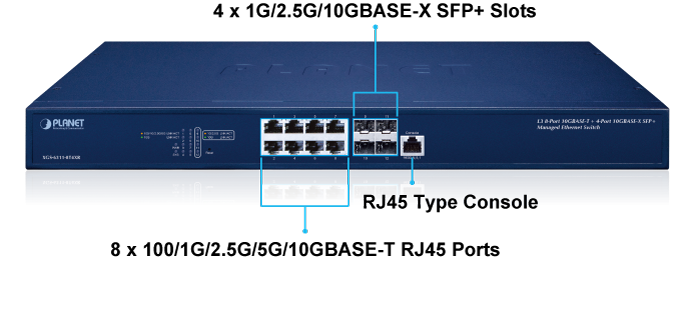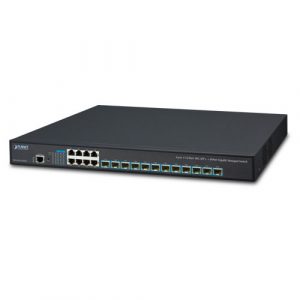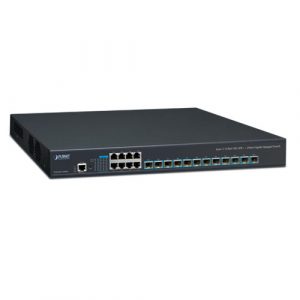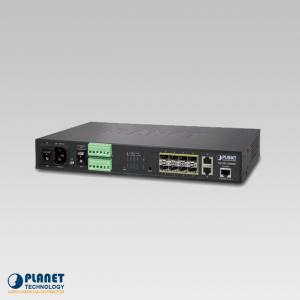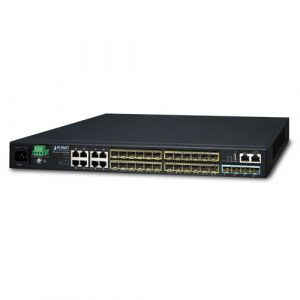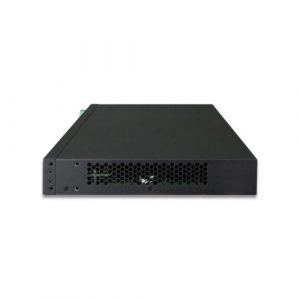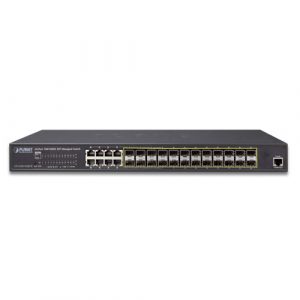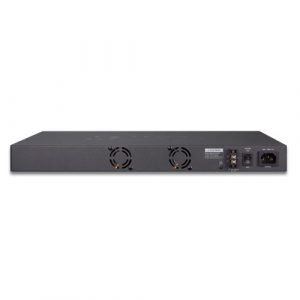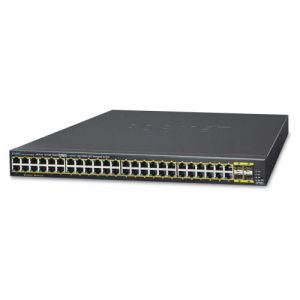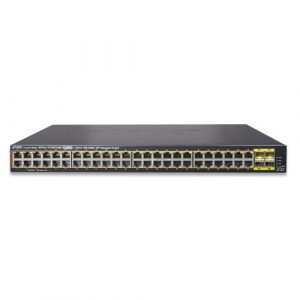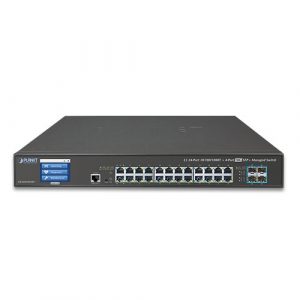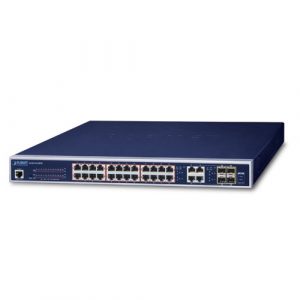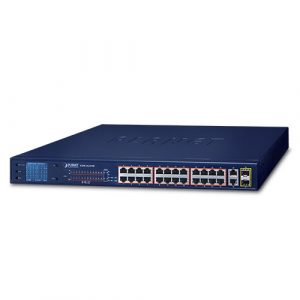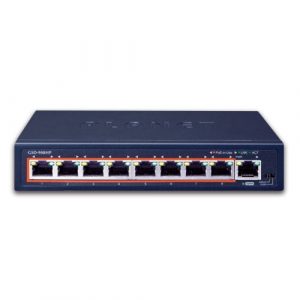XGS-6311-8T4XR
L3 8-Port 10GBASE-T + 4-Port 10GBASE-X SFP+ Managed Ethernet Switch with Dual 100~240V AC Redundant Power
- Applicazioni
- SPECIFICHE
- DOWNLOAD
Descrizione
NMS integrato per migliorare l’efficienza di gestione degli switch di rete Layer 3 a 10 Gbps
PLANET XGS-6311-8T4XR è uno switch Ethernet 10 Gbps completamente gestito, con tutte le porte, che può essere combinato con PLANET UNI-NMS per semplificare ed aumentare l’efficienza della gestione della rete. È progettato per AP wireless Wi-Fi 6/6E/7, NAS e workstation che richiedono un’elevata larghezza di banda. Dispone di 8 porte RJ45 10GBASE-T e 4 porte in fibra ottica SFP+ 10GBASE-X, progettate in modo flessibile per estendere la distanza di connessione.
XGS-6311-8T4XR offre prestazioni ad alta densità, routing statico IPv4/IPv6 Layer 3, RIP (Routing Information Protocol) e OSPF (Open Shortest Path First), con interfacce a 10 Gbps.
Grazie a una capacità di collegamento dati così favorevole, alle prestazioni di routing di Livello 3 basate su hardware, al motore di commutazione di Livello 2 e alle interfacce di gestione IPv6/IPv4 intuitive ma avanzate, contribuisce ad accelerare l’implementazione della rete di nuova generazione ad alta larghezza di banda, necessaria per aree metropolitane, smart city e aziende.
Tramite PLANET UNC-NMS, gli amministratori possono gestire centralmente una rete fino a 102.400 nodi da una sede centrale, migliorando così notevolmente l’efficienza della gestione di rete e dell’alimentazione. Grazie alla gestione dell’autenticazione utente, combinata con UNI-NMS, la sicurezza della trasmissione dati nei moderni sistemi di automazione industriale risulta migliorata.
Soluzione di rete PLANET NMSViewerPro
XGS-6311-8T4XR integra perfettamente le funzionalità di PLANET NMS e NMSViewerPro, offrendo agli utenti un’esperienza fluida e intuitiva. Sfruttando la connettività Internet degli smartphone, è possibile monitorare in tempo reale il traffico di rete, le impostazioni di configurazione e l’esecuzione della risoluzione dei problemi. Può accedere a una vasta gamma di informazioni sui dispositivi archiviate nel cloud, consentendo una comprensione completa della rete. Gli utenti possono beneficiare del monitoraggio e del controllo in tempo reale degli access point, indipendentemente dalla loro posizione o dal fuso orario.
Soluzione di rete mesh ad alta disponibilità per sistemi Big Data
Grazie a funzionalità altamente flessibili, estensibili e facili da installare, l’XGS-6311-8T4XR offre una velocità di scambio dati fino a 240 Gbps tramite interfaccia in fibra ottica, con una distanza di trasmissione che può essere estesa fino a 120 km. L’XGS-6311-8T4XR offre una capacità di autoripristino rapida ed efficiente per prevenire interruzioni e intrusioni esterne. Integra il protocollo MSTP (Multiple Spanning Tree Protocol, spanning tree tramite VLAN) IEEE 802.1s nella rete di automazione del cliente per migliorare l’affidabilità e i tempi di attività del sistema. L’XGS-6311-8T4XR è la soluzione ideale per data center, service provider e aziende di telecomunicazioni che desiderano creare connessioni ridondanti e stabilire un’elevata larghezza di banda per la server farm Big Data.
Routing VLAN Layer 3
Grazie ai robusti protocolli di routing del traffico Layer 3 integrati, l’XGS-6311-8T4XR garantisce un routing affidabile tra VLAN e segmenti di rete. I protocolli di routing possono essere applicati tramite l’interfaccia VLAN. L’XGS-6311-8T4XR è sicuramente una soluzione conveniente e ideale per le aziende.
Supporto al routing di Livello 3
XGS-6311-8T4XR consente all’amministratore di aumentare l’efficienza della rete configurando manualmente il routing statico di Livello 3 e automaticamente le impostazioni RIP o OSPF. Il RIP può utilizzare il numero di hop come metrica di routing e prevenire loop di routing implementando un limite al numero di hop consentiti in un percorso dalla sorgente alla destinazione. L’OSPF è un protocollo di routing dinamico interno per sistemi autonomi basato sullo stato dei collegamenti. Il protocollo crea un database per lo stato dei collegamenti scambiando gli stati dei collegamenti tra gli switch di Livello 3 e quindi utilizza l’algoritmo Shortest Path First per generare una tabella di routing basata su tale database.
| Hardware Specifications | |
|---|---|
| Copper Ports | 8 100/1G/2.5G/5G/10GBASE-T RJ45 auto negotiation ports (Ports 1 to 8) |
| SFP+ Slots | 4 10GBASE-X SFP+ interfaces (Ports 9 to 12) Compatible with 1G/2.5GBASE-SX/LX/BX SFP transceiver |
| Console | 1 x RJ45-to-RS232 serial port (9600, 8, N, 1) |
| CPU | MIPS 800MHz |
| RAM | 512Mbytes |
| Flash Memory | 32Mbytes |
| Dimensions (W x D x H) | 441.5 x 207.5 x 44 mm, 1U height |
| Weight | 2831g |
| Power Consumption | Max. 22.3 watts/76BTU (Power on without any connection) Max. 56 watts/190.96 BTU (Full loading) |
| Power Requirements | Dual AC 100~240V, 50/60Hz |
| Fan | 2 |
| LED |
System: PWR (Green), SYS (Green) Ports: 10GBASE-X SFP+ Ports (Ports 9 to 12) |
| Switching Specifications | |
| Switch Architecture | Store-and-forward |
| Switch Fabric | 240Gbps/non-blocking |
| Switch Throughput | 178.56Mpps |
| Address Table | 32K MAC address table with auto learning function |
| ARP Table | 8K |
| Routing Table | 12K |
| IP Interface | 1024 |
| ACL Table | 4K |
| Shared Data Buffer | 16MB |
| Flow Control | Back pressure for half duplex IEEE 802.3x pause frame for full duplex |
| Jumbo Frame | 12KB |
| IPv4 Layer 3 Functions | |
| IP Routing Protocol | Static route RIPv1/v2 OSPFv2 BGP4 Hardware-based Layer 3 routing |
| Layer 3 Protocol | ARP ARP Proxy IGMP Proxy |
| IPv6 Layer 3 Functions | |
| IP Routing Protocol | IPv6 Static Route RIPng OSPFv3 BGP6 (BGP4+) PIM6 IPv6 RA (Router Advertisement) IPv6 LPM Routing Hardware-based Layer 3 routing SNMP over IPv6 Support IPv6 IPSec Support IPv6 ACL |
| Other | ICMPv6,ND,DNSv6 DNS over IPv6 Support |
| Layer 2 Function | |
| Port Configuration | Port disable/enable Flow control disable/enable Bandwidth control on each port Port loopback detect |
| Port Status | Display each port’s speed duplex mode, link status, flow control status and auto negotiation status |
| VLAN | 802.1Q tagged based VLAN, up to 4K VLAN groups 802.1ad Q-in-Q (VLAN stacking) GVRP for VLAN management Private VLAN Edge (PVE) supported Protocol-based VLAN MAC-based VLAN IP subnet VLAN |
| Bandwidth Control | TX/RX/Both |
| Link Aggregation | IEEE 802.3ad LACP/static trunk Supports 64 groups with 8 ports per trunk group |
| QoS | 8 priority queues on all switch ports Supports strict priority and Weighted Round Robin (WRR) CoS policies Traffic classification: IEEE 802.1p CoS/ToS IPv4/IPv6 DSCP Port-based WRR |
| Multicast | IPv4 IGMP v1/v2/v3 snooping IPv4 Querier mode support IPv6 MLD v1/v2 snooping Multicast VLAN Register (MVR) Up to 1024 |
| Security Function | |
| Access Control List | Supports Standard and Expanded ACL IP-based ACL/MAC-based ACL Time-based ACL Up to 2K entries |
| Security | Port isolation Supports IP + MAC + port binding Identification and filtering of L2/L3/L4 based ACL Defend against DOS or TCP attacks Suppression of broadcast, multicast and unknown unicast packet DHCP Snooping, DHCP Option 82/43/60/61/67 Command line authority control based on user levels |
| AAA | TACACS+ and IPv4/IPv6 over RADIUS |
| Authentication | IEEE 802.1x port-based network access control |
| Management Function | |
| System Configuration | Console, Telnet, Web browser, SNMP v1, v2c |
| Secure Management Interfaces | SSHv2, TLSv1.2, SNMPv3 |
| Management | IPv4 and IPv6 dual stack management SNMP over IPv6 Support User IP security inspection for IPv4/IPv6 SNMP SNMP v1, v2c and v3 SNMP MIB and TRAP SNMP RMON 1, 2, 3, 9 four groups HTTP over IPv6 Supports IPv4/IPv6 FTP/TFTP IPv4/IPv6 SNTP/NTP Supports ping, trace route function for IPv4 and IPv6 RADIUS authentication for IPv4/IPv6 Telnet user name and password IPv4/IPv6 SSH IPv4/IPv6 Telnet IPv6 Radius+ Support The right configuration for users to adopt RADIUS server’s shell management CLI, console, Telnet Security IP safety net management function: avoid unlawful landing at nonrestrictive area Syslog server for IPv4 and IPv6 IPv6 TACACS+ support PLANET Smart Discovery Utility PLANET NMS PLANET NMSViewerPro |
| SNMP MIBs | RFC 1213 MIB-II RFC 1215 Internet Engineering Task Force RFC 1271 RMON RFC 1354 IP-Forwarding MIB RFC 1493 Bridge MIB RFC 1643 Ether-like MIB RFC 1907 SNMP v2 RFC 2011 IP/ICMP MIB RFC 2012 TCP MIB RFC 2013 UDP MIB RFC 2096 IP forward MIB RFC 2233 if MIB RFC 2452 TCP6 MIB RFC 2454 UDP6 MIB RFC 2465 IPv6 MIB RFC 2466 ICMP6 MIB RFC 2573 SNMP v3 notify RFC 2574 SNMP v3 vacm RFC 2674 Bridge MIB Extensions (IEEE 802.1Q MIB) RFC 2674 Bridge MIB Extensions (IEEE 802.1P MIB) |
| Standard Conformance | |
| Regulatory Compliance | FCC Part 15 Class A, CE |
| Standards Compliance | IEEE 802.3 10BASE-T IEEE 802.3u 100BASE-TX IEEE 802.3z Gigabit 1000BASE-SX/LX IEEE 802.3ab Gigabit 1000BASE-T IEEE 802.3ae 10Gb/s Ethernet IEEE 802.3x flow control and back pressure IEEE 802.3ad port trunk with LACP IEEE 802.1ag CFM IEEE 802.1D Spanning Tree Protocol IEEE 802.1w Rapid Spanning Tree Protocol IEEE 802.1s Multiple Spanning Tree Protocol IEEE 802.1p Class of Service IEEE 802.1Q VLAN tagging IEEE 802.1X port authentication network control IEEE 802.1ab LLDP RFC 768 UDP RFC 783 TFTP RFC 793 TCP RFC 791 IP RFC 792 ICMP RFC 2068 HTTP RFC 1112 IGMP v1 RFC 2236 IGMP v2 RFC 3376 IGMP v3 RFC 2710 MLD v1 FRC 3810 MLD v2 RFC 2328 OSPF v2 RFC 1058 RIP v1 RFC 2453 RIP v2 ITU-T G.8032 ERPS Ring |
| Environment | |
| Operating | Temperature: 0 ~ 50 degrees C Relative Humidity: 5 ~ 90% (non-condensing) |
| Storage | Temperature: -10 ~ 70 degrees C Relative Humidity: 5 ~ 90% (non-condensing) |





